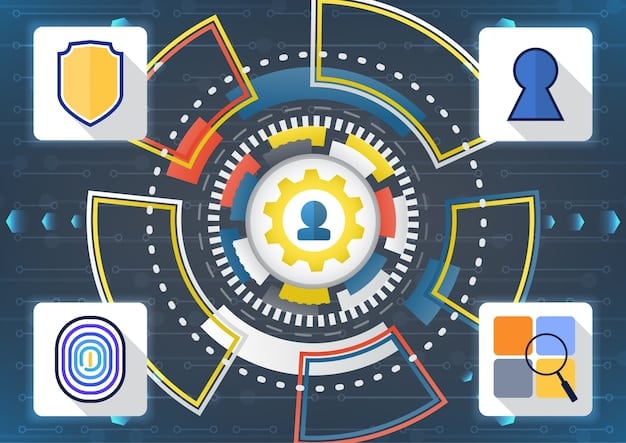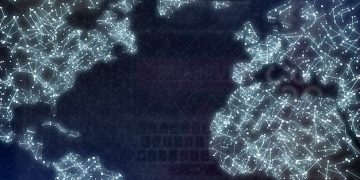New Cybersecurity Threats: What US Tech Startups Face in Q3 2025

US tech startups in Q3 2025 must prioritize sophisticated AI-driven attacks, supply chain vulnerabilities, deepfakes, and evolving ransomware variants to safeguard innovation and maintain competitive integrity within a rapidly shifting threat landscape.
As the digital frontier expands, so too do the shadows of cyber threats. For nimble US tech startups, navigating this intricate landscape in mid-2025 demands foresight and strategic prioritization. Understanding what new cybersecurity threats US tech startups should prioritize in Q3 2025 is not merely an IT concern, but a foundational element for sustained growth, innovation, and trust in a highly competitive market.
The Evolving Threat Landscape for Tech Startups
The pace of technological advancement, while driving innovation, simultaneously creates new avenues for malicious actors. For US tech startups, the unique combination of rapid development cycles, often lean security teams, and a rich intellectual property portfolio makes them particularly attractive targets. The third quarter of 2025 will likely see an acceleration of existing trends coupled with the emergence of novel attack vectors, demanding a proactive and informed defense strategy.
Cybersecurity is no longer just about firewalls and antivirus software; it’s about understanding the psychology of the attacker, anticipating their next move, and building resilience into every layer of the business. Startups, by their very nature, are agile and adoptive, traits that can be leveraged for robust security practices rather than seen as limitations. The key lies in shifting from a reactive posture to a predictive one, prioritizing threats not just by their immediate impact but by their potential for systemic disruption.
Consider the increasing reliance on cloud infrastructure. While offering unparalleled scalability and flexibility, cloud environments also present a broader attack surface if not configured and monitored meticulously. Startups, eager to leverage these benefits, must ensure their cloud security posture keeps pace with their deployment speed. Similarly, the open-source software ecosystem, a cornerstone of many tech startups, introduces its own set of challenges, particularly regarding supply chain integrity.
AI-Driven Attacks and Adversarial Machine Learning
One of the most significant shifts expected by Q3 2025 is the widespread weaponization of artificial intelligence in cyberattacks. Attackers will increasingly employ AI to automate reconnaissance, craft highly convincing phishing campaigns, and even adapt exploits in real-time, making traditional rule-based defenses less effective. This escalating sophistication demands a reciprocal evolution in defense.
Sophisticated Phishing and Social Engineering
AI can analyze vast amounts of public data to create hyper-personalized phishing emails and social engineering tactics that are nearly indistinguishable from legitimate communications. This includes voice cloning for vishing (voice phishing) and deepfake videos for CEO fraud or extortion attempts. Startups, with their often smaller teams and less formalized communication protocols, can be particularly susceptible.
- AI-generated spear phishing emails tailored to individual employees.
- Deepfake audio/video used for convincing impersonations.
- Automated reconnaissance for identifying key personnel and vulnerabilities.
- Adaptive malware leveraging AI to bypass detection systems.
Adversarial Machine Learning
Beyond generating attacks, AI can be used to fool existing AI-powered security systems. Adversarial machine learning involves subtly altering input data to trick AI models into misclassifying malicious activity as benign, or vice-versa. This can bypass AI-driven anomaly detection systems, allowing threats to persist undetected within a network. This requires startups to invest in explainable AI (XAI) security solutions that can identify and defend against such manipulations.
The core challenge for startups is that these AI-driven threats can scale rapidly and bypass human intuition. Training employees to recognize subtle inconsistencies becomes exponentially harder when the “scam” is crafted by an AI with access to vast data points. Therefore, defense must also involve AI, specifically in threat intelligence, anomaly detection, and automated incident response, making it one of the most critical areas for prioritization.
Supply Chain Vulnerabilities and Third-Party Risks
The interconnected nature of modern software development means that a single vulnerable component in a third-party library or service can compromise an entire product or system. For tech startups, heavily reliant on open-source software, cloud providers, and various APIs, supply chain security is a paramount concern that will intensify dramatically by Q3 2025.
Software Supply Chain Attacks
These attacks target vulnerabilities in the software development lifecycle, from code repositories to build pipelines. Malicious code injected into widely used libraries or dependencies can propagate across numerous downstream applications. A single compromised open-source package can affect thousands of development efforts, including those of nascent tech startups building their core products.
This means startups need far more rigorous vetting processes for all third-party components, not just at the point of integration, but continuously throughout their lifecycle. Automated tools for software composition analysis (SCA) become indispensable.
Third-Party and Nth-Party Risks
Beyond software, startups rely on a myriad of SaaS providers, cloud vendors, and other service providers. A breach at any of these ‘nth-party’ vendors can directly impact the startup, compromising sensitive data or access credentials. Establishing robust vendor risk management programs is no longer optional; it is essential. This includes due diligence, regular security audits, and clear contractual obligations regarding data protection.
- Vetting all third-party and fourth-party vendors for security posture.
- Implementing Software Composition Analysis (SCA) for all dependencies.
- Establishing strong contractual clauses for data protection with suppliers.
- Continuous monitoring of the integrity of development pipelines.
For many startups, the challenge lies in balancing speed of development with the due diligence required for robust supply chain security. However, the cost of a supply chain breach – in terms of financial loss, reputational damage, and intellectual property theft – far outweighs the perceived overhead of proactive security measures.

Ransomware Evolution and Data Extortion
Ransomware continues its reign as a top threat, but its evolution by Q3 2025 will make it even more insidious for tech startups. The shift from mere data encryption to multifaceted extortion tactics, coupled with more sophisticated delivery mechanisms, means startups face not just operational disruption but also severe reputational and legal consequences.
Double and Triple Extortion
Attackers no longer just encrypt data and demand payment for decryption. They now routinely exfiltrate sensitive data before encryption, threatening to publish it publicly if the ransom isn’t paid. This “double extortion” puts immense pressure on organizations, as data breaches carry regulatory fines and severe reputational damage. “Triple extortion” adds another layer, involving direct attacks or threats against the victim’s customers, partners, or even physical harassment.
Targeted and Stealthy Attacks
Ransomware campaigns are becoming less opportunistic and more targeted. Threat actors will conduct extensive reconnaissance to identify high-value targets, including tech startups with valuable intellectual property or access to customer data. Attacks are also becoming stealthier, residing undetected in networks for longer periods to maximize data exfiltration before encryption.
Protecting against ransomware requires a multi-layered defense strategy. This includes robust endpoint detection and response (EDR), strong identity and access management (IAM), regular data backups (with offline copies), and, critically, comprehensive incident response plans that are regularly tested.
Emerging Variants and Techniques
New ransomware strains are constantly emerging, employing novel encryption methods, evasion techniques, and propagation mechanisms. Some variants can now encrypt cloud-based data storage directly, bypassing traditional on-premise defenses. Tech startups, with their often cloud-native infrastructure, need to ensure their cloud configurations are hardened against such attacks.
The focus for startups must be on prevention first, but also on rapid detection and recovery. Investing in robust backup and disaster recovery solutions is as crucial as preventative measures, as even the most secure systems can eventually be breached.
State-Sponsored Attacks and Industrial Espionage
While often associated with large corporations or government agencies, tech startups are increasingly becoming targets for state-sponsored threat actors. These groups aim to steal intellectual property, gain economic advantage, or disrupt critical infrastructure, and they often view innovative startups as a soft entry point into broader networks or as direct sources of valuable technology.
Espionage and IP Theft
Many state-sponsored groups focus on industrial espionage, seeking to acquire trade secrets, research and development data, and proprietary algorithms. For tech startups, whose core value often lies in their unique innovations, such breaches can be catastrophic, undermining years of investment and competitive advantage. The stealthy nature of these attacks, often involving advanced persistent threats (APTs), makes them difficult to detect.
Supply Chain Infiltration
State actors might also target startups as a means to infiltrate larger supply chains. By compromising a smaller, less aggressively defended startup that supplies to larger entities or government contractors, they can achieve a much broader impact. This makes startups not just direct targets, but potential stepping stones for larger geopolitical objectives.
Defense against state-sponsored attacks requires a higher level of vigilance and sophistication. It involves advanced threat intelligence, anomaly detection, continuous monitoring, and a strong emphasis on insider threat programs, as these attacks often leverage compromised credentials or disaffected employees.
Critical Infrastructure and Destructive Attacks
While less common for individual startups, a tech startup developing core technologies or services that could be deemed critical infrastructure (e.g., in energy, finance, or communication) could become a target for destructive attacks aimed at disruption. These are designed to cause widespread damage, not just data theft.
For startups, identifying whether they possess data or technology attractive to state adversaries is the first step. This realization should drive a more comprehensive security strategy, including layered defenses, robust threat hunting, and possibly engaging with government security agencies for intelligence sharing.
Vulnerabilities in Emerging Technologies (Web3, IoT, Quantum-Resistant Crypto)
The very technologies that drive innovation for startups also introduce new and complex security vulnerabilities. As Web3, IoT, and initial quantum-resistant cryptographic solutions become more prevalent by Q3 2025, their inherent complexities will create novel attack surfaces.
Web3 and Blockchain Security
While blockchain technology is designed for security and immutability, the applications built on top of it (dApps, smart contracts, NFTs) are often fraught with vulnerabilities. Logic bugs in smart contracts can lead to massive financial losses, as demonstrated by numerous exploits in DeFi (Decentralized Finance) and NFT projects.
For startups building on Web3, code audits, formal verification of smart contracts, and secure development lifecycle practices specific to blockchain are non-negotiable.
Internet of Things (IoT) Security
The proliferation of IoT devices, from smart sensors to industrial controls, introduces a vast number of new endpoints to networks. Many IoT devices suffer from weak default security, lack of regular updates, and insecure communication protocols. A compromised IoT device can serve as an entry point for attackers to traverse a startup’s internal network. Segregating IoT networks, implementing strong authentication, and regular patching are crucial.
Quantum-Resistant Cryptography Gaps
While quantum computing is still nascent, the race for quantum-resistant cryptography (QRC) is on. By Q3 2025, some early QRC implementations might be in use, and any flaws or misconfigurations in these new, complex algorithms could lead to significant vulnerabilities. Startups experimenting with QRC must ensure their implementations are robust and adhere to evolving standards.
- Thorough smart contract audits for Web3 applications.
- Network segmentation for IoT devices.
- Secure code development practices specifically for emerging tech stacks.
- Early adoption and rigorous testing of quantum-resistant cryptographic solutions.
Navigating these emerging tech vulnerabilities requires specialized expertise. Startups should consider collaborating with security researchers or consulting firms that specialize in these niche areas to avoid costly early-adoption mistakes that could be exploited.
The Human Element: Insider Threats and Skill Gaps
Despite all technological advancements, the human element remains both the strongest and weakest link in cybersecurity. By Q3 2025, the challenge for US tech startups will involve mitigating insider threats, both malicious and accidental, and addressing the persistent skill gap in cybersecurity talent.
Malicious and Accidental Insider Threats
Insiders, whether disgruntled employees, those coerced by external actors, or simply careless staff, pose a unique threat. Malicious insiders can steal data, sabotage systems, or open backdoors for external actors. Accidental insiders, through phishing clicks or mishandling sensitive data, can inadvertently create significant vulnerabilities. Startups, with their often close-knit yet rapidly expanding teams, must instill a strong security culture from day one.
The Persistent Cybersecurity Skill Gap
The demand for skilled cybersecurity professionals far outstrips supply, a gap projected to widen by 2025. This makes it challenging for startups to hire and retain top talent, leaving them reliant on less experienced staff or external consultants. This skill gap directly impacts a startup’s ability to implement robust defenses, detect sophisticated attacks, and respond effectively to incidents.
Addressing the human element requires a multifaceted approach: comprehensive security awareness training (ongoing, not just annual), robust access controls (Least Privilege), continuous monitoring of user behavior, and fostering a culture where security is everyone’s responsibility.
Employee Training and Awareness
Regular, engaging, and relevant training sessions are crucial. These should cover everything from phishing recognition and password hygiene to secure coding practices and data handling protocols. Simulating phishing attacks can also be an effective way to gauge and improve employee vigilance.
Ultimately, a startup’s security posture is only as strong as its weakest link. Investing in people, through training and culture-building, is as critical as investing in technology when prioritizing cybersecurity threats.

| Key Area | Prioritization Scope for Q3 2025 |
|---|---|
| 🤖 AI-Driven Attacks | Focus on advanced phishing, deepfakes, and adversarial AI defense. |
| ⛓️ Supply Chain Vulnerabilities | Implement rigorous third-party vendor risk and software component analysis. |
| 💸 Ransomware & Extortion | Enhance data backup, EDR, and comprehensive incident response plans. |
| 👤 Human Element | Invest in continuous security awareness training and culture building. |
Frequently Asked Questions About Startup Cybersecurity Threats
US tech startups are often vulnerable due to rapid development cycles, smaller dedicated security teams, and a focus on innovation that can sometimes deprioritize early security integration. Their valuable intellectual property and access to sensitive data also make them attractive targets for various malicious actors seeking financial gain or competitive advantage.
Defending against AI-driven attacks requires an adaptive approach. This includes implementing AI-powered security solutions for anomaly detection and behavior analytics, providing advanced employee training on deepfake recognition, and leveraging threat intelligence that tracks AI-generated attack patterns. Regular security audits and penetration testing are also vital to identify potential weaknesses.
Supply chain risk refers to vulnerabilities stemming from third-party software, libraries, and services a startup relies on. Mitigation involves rigorous vendor vetting, continuous Software Composition Analysis (SCA) to identify known vulnerabilities in code dependencies, and establishing strong contractual security requirements with all suppliers. Proactive monitoring of the entire development pipeline is also essential.
Yes, ransomware remains a major threat, evolving with tactics like “double” and “triple” extortion, where data is exfiltrated and threatened for public release, besides encryption. Attacks are also more targeted and stealthy. Startups need robust backup strategies, advanced endpoint detection and response (EDR), and comprehensive, well-practiced incident response plans to minimize impact.
Extremely important. The human element is often the weakest link. Comprehensive, ongoing security awareness training for all employees, covering phishing, social engineering, data handling, and secure computing practices, significantly reduces the risk of accidental breaches and makes it harder for malicious insiders or external attackers to succeed. A strong security culture is paramount.
Conclusion
The cybersecurity landscape for US tech startups in Q3 2025 is dynamic and demanding. Prioritizing threats like AI-driven attacks, supply chain vulnerabilities, evolving ransomware, state-sponsored espionage, and emerging tech flaws is not a luxury, but a strategic imperative. Coupling advanced technological defenses with a strong security culture and continuous employee education will be the cornerstone of resilience, ensuring these innovative companies can continue to thrive securely in an increasingly complex digital world. Proactive engagement and adaptability will be key to outmaneuvering adversaries and safeguarding the future of innovation.





